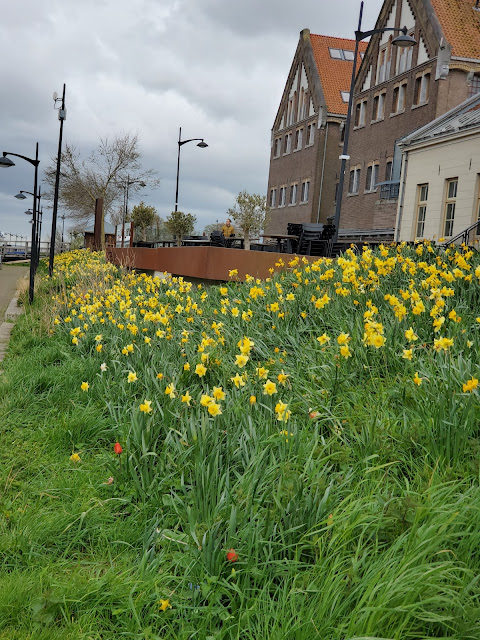 |
| Tulips come in a range of colors and patterns, featuring mostly reds and yellows. |
Having been essentially house-bound for the past two years, I recently had the good fortune to visit the Netherlands with my family. Most specifically I wanted to see the famous tulip displays at the Keukenhof Garden. The garden is located at the village of Lisse, in the middle of the bulb-growing region of the country, a 40-minute bus ride from Amsterdam. I was lucky to arrive at the peak of the tulip display in mid-April. I wasn't alone!
The garden is only open to the public from mid-March to early May each year the Amsterdam Tulip Festival. People come from all over the world for the display that features 800 varieties of tulips, along with daffodils, hyacinth, crocus, fritillaries, and grape hyacinth. Covered pavilions also host displays of orchids, anthuriums, and orchids.
Prior to the pandemic, about 1.5 million people, or about 26,000 per day, visited during the brief season. With the garden closed for the past two years, pent-up tulip cravings brought crowds rivaling those at Disney World the day after Christmas. This is the present-day version of tulip mania.
There are about 75 wild species of tulips, native to southeastern Europe, the middle east, and central Asia. From these, thousands of cultivars and hybrids have been created.
 |
| Two wild Asian species of the genus Tulipa on display at Keukenhof Garden. (this article at least has some genuine wildflowers!) |
The original "tulip mania" occurred in the Netherlands during the 17th century. This was at the height of the Dutch empire and prosperity, and the Dutch were the leading growers and breeders of tulips and other bulbs at that time. Rare varieties sold for hundreds or thousands of Guilders. I don't know how much a Guilder at that time was worth in today's dollars, but I'm sure it's a lot. Tulips and tulip "futures" were traded on exchanges similar to our modern stock exchange. An investment frenzy began in 1634, creating the first recorded investment "bubble." When the tulip market collapsed in 1637, huge fortunes were lost.
Today, many of you in temperate parts of the world can enjoy the fruits of the Dutch tulip breeders efforts in your own backyards and local parks, though we in Florida are restricted to paltry, short-lived potted specimens from our florists and grocery stores!
In any case, now enjoy the pictures of tulip mania 2022 in Koekenhof.
 |
| A bed of brilliant orange and yellow tulips near the front entrance. |
 |
| A "river" of grape hyacinth meanders through banks lined with daffodils. |
 |
| Rare varieties of tulips are displayed inside the Willem-Alexander Pavilion. |
 |
| A bed of orange and yellow tulips in front of a river of pink hyacinths. |
 |
| A bed of crown fritillaries. |
 |
| The spectacular display of roses in the Oranje Nassau Pavilion. |
 |
| In Amsterdam, potted tulips line the square near the Rijksmuseum. |
 |
| An embankment near the Amsterdam waterfront is filled with Daffodils that reappear year after year without human help. |

No comments:
Post a Comment
Note: Only a member of this blog may post a comment.